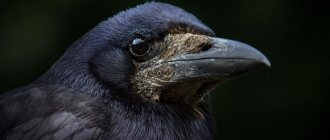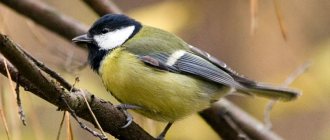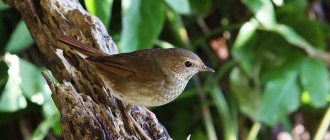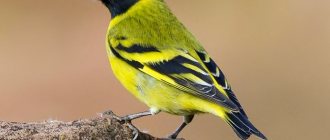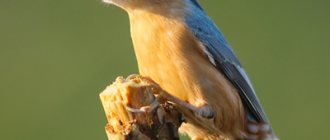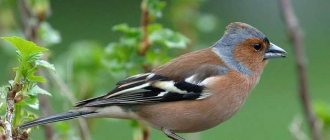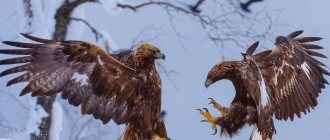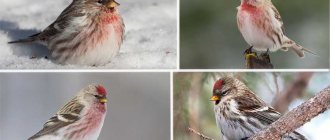Appearance and description of the black swift
Black swifts have a body reaching a length of 18 cm with a wingspan of 40 cm . The average wing length of an adult is approximately 16-17 cm. The forked tail of the bird is 7-8 cm long. The tail plumage is unremarkable, of an ordinary dark brown color with a slight greenish-metallic tint.
On short, but very strong legs, there are four forward-facing toes, which are equipped with fairly sharp and tenacious claws. With a body weight of 37-56 g, black swifts are perfectly adapted to their natural habitat, where their life expectancy is a quarter of a century, and sometimes more.
This is interesting! The black swift is the only bird capable of eating, drinking, mating, and sleeping while flying. Among other things, this bird can spend several years in the air, without landing on the surface of the earth.
With their shape, swifts resemble swallows. A rounded whitish spot is clearly visible on the throat and chin. The eyes have a dark brown color. The beak is black, and the paws are characterized by a light brown color.
The short beak has a very wide mouth opening. There are no differences in the plumage of males and females, but the peculiarity of young individuals is a lighter shade of feathers with a dirty white border. In summer, the plumage can fade greatly, so the appearance of the bird becomes even more inconspicuous.
Return to content
Offspring
The female usually lays 2 eggs, with rare exceptions there may be more. The eggs are elongated, whitish in color, length - 2.6 cm, width - 1.6 cm. The female incubates the eggs, and the male feeds her at this time.
Hatched chicks need food. Both parents take care of the offspring. During one visit of the parent, only one chick receives food.
Birds eat small and other insects. The male does not swallow the small ones one at a time, but collects them in his beak until they turn into a lump along with saliva. Only when the lump is ready does the swift swallow it or carry it to the swiftlets. Swifts are voracious, they kill a lot of insects, but most of them do not benefit humans.
Under the influence of external factors, when it becomes cool outside, the chicks’ body temperature may drop: 2-3ᵒ C above atmospheric. This state of absolute hunger can last 5-10 days. During this period, the shearer's body feeds on accumulated fat deposits.
Living in the wild
Swifts belong to the category of very common bird species, so residents of megacities may encounter the so-called “swift problem,” which consists of a mass flight of chicks that cannot fly well from the nest.
Habitats and geography
The main habitat of the black swift is Europe, as well as the territory of Asia and Africa . Swifts are migratory birds, and at the very beginning of the nesting season they fly to European and Asian countries.
This is interesting! Initially, the main habitat of the black swift was mountainous areas, which were overgrown with dense forested vegetation, but now this bird is increasingly settling en masse in close proximity to people’s homes and natural bodies of water.
It is the temperate climate zone that allows this bird in the spring and summer to obtain a good food supply, represented by different types of insects. With the onset of autumn cold weather, swifts get ready to travel and fly to the southern part of Africa, where they successfully winter.
Lifestyle of a black swift
Black swifts are rightly considered to be very noisy and sociable birds, which most often settle in small, noisy colonies. Adults spend a significant part of their time outside the nesting season in flight.
Birds of this species are capable of flapping their wings frequently and flying very quickly. A specific feature is the ability to perform gliding flight. In the evening, on fine days, black swifts quite often organize a kind of aerial “race”, during which they make very sharp turns and fill the surrounding area with loud cries.
This is interesting! A characteristic feature of this species is the lack of the ability to walk. With the help of short and very strong legs, birds easily cling to any rough surfaces on vertical walls or steep cliffs.
Diet, nutrition, swift prey
The basis of the black swift's diet consists of all kinds of winged insects, as well as small spiders that move through the air on their webs . To find enough food for itself, the bird is able to fly long distances during the day. On cold, stormy days, winged insects practically do not rise into the air, so swifts have to fly several hundred kilometers in search of food. The bird catches its prey with its beak, like a net. Black swifts also drink in flight.
This is interesting! In the capital and other fairly large cities, one of the few birds capable of exterminating a huge number of pests, including poplar moths and mosquitoes, is the black swift.
If necessary, not only high-rise buildings, trees, poles and wires, but also the air space where the bird soars freely and dozes until dawn, becomes a place for them to spend the night. Adult swifts are able to rise to a height of up to two to three kilometers.
It should be noted that adult individuals can lose a third of their body weight with absolutely no visible damage to health and with complete preservation of motor activity.
Return to content
Wintering
For the winter, swifts travel to Africa in mixed flocks. They fly close to each other, reaching speeds of up to 250 km/h. They get to the place quickly, in 4–5 days.
The migration patterns of black swifts were studied by a group of scientists from Sweden led by Suzanne Akesson. Researchers tracked the movements of hundreds of individuals from different European populations for several years and came to the following conclusions:
- the northern populations went for the winter and returned home a month later than the southern ones;
- Lapland swifts migrated to the west of Africa and to the central regions, Italian and Spanish populations, in addition to the central part of the continent, inhabited the southeast of the continent;
- unlike other warm-blooded species, representatives of the northern colonies weigh less than those living in the south;
- small body size makes it easier to endure the hot African climate;
- competition for nesting sites in the southern regions caused an increase in body weight.
The timing of migration depends not only on the length of daylight hours, but also on the weather.
The main enemies of birds
In nature, such an excellent flyer as the black swift has practically no enemies . However, swifts are hosts of specific parasites - cavity mites, which can cause quite serious diseases in both young birds and adult birds.
At the end of the nineteenth century, massive destruction of black swift nests was observed in Southern Europe. This situation was due to the popularity of the meat of the chicks of this species, which was considered a delicacy. Sometimes swifts, especially sick ones, become easy prey for birds of prey and cats.
This is interesting! Quite a large number of individuals die as a result of accidental collisions with wires on power lines.
Return to content
Features of character and lifestyle
Photo: Black Swift
Swifts are a very sociable bird species. They typically nest, live, migrate and hunt for food in groups throughout the year. Additionally, these birds are unique in their ability to remain aloft for long periods of time. They often spend the entire day on the wing, only landing to feed young chicks or roost at night. Common swifts are estimated to fly at least 560 km per day during the nesting season, demonstrating their stamina and strength, as well as their incredible aerial abilities.
Swifts can also mate and forage for food while in the air. Birds prefer to fly in lower airspace when the weather is bad (cold, windy and/or high humidity), and move to higher airspace when the weather is favorable for prolonged aerial activity.
Interesting fact: In August and September, swifts leave Europe and begin their journey to Africa. Sharp claws are extremely useful during this flight. Although the chicks hatch before migration begins, observations indicate that many young individuals do not survive the long journey.
Swifts can nest in former woodpecker cavities found in forests, for example about 600 nesting birds in Belovezhskaya Pushcha. In addition, swifts have adapted to nesting in artificial areas. They build their nests from airborne material captured in flight and combined with their saliva, in the cavities of buildings, in gaps under window sills and under eaves and inside gables.
Reproduction of the black swift
Quite large flocks of black swifts arrive for nesting, as a rule, at the end of April or in the first ten days of May. Almost the entire mating season and “family life” of this bird takes place in flight, where not only the search for a partner is carried out, but also mating and even the collection of basic materials for the subsequent construction of a nest.
The bird glues all the feathers and fluff collected into the air, as well as dry straws and blades of grass, using a special secretion from the salivary glands. The nest being constructed has the characteristic shape of a small cup with a fairly large entrance. In the last ten days of May, the female lays two or three eggs. For three weeks, the clutch is incubated alternately by a male and a female. Naked chicks are born, which relatively quickly become overgrown with grayish fluff.
Swift chicks are under the care of their parents until they are one and a half months old. If the parents are absent for too long, the chicks are able to fall into a kind of torpor, which is accompanied by a decrease in body temperature and slower breathing. Thus, the accumulated fat reserves allow them to withstand a week-long fast with relative ease.
This is interesting! When their parents return, the chicks emerge from a state of forced hibernation, and as a result of increased nutrition, they very quickly gain lost body weight. During the feeding process, the parent is able to bring approximately a thousand insects in its beak at a time.
Black swifts feed their chicks with all kinds of insects, having previously glued them together with saliva into small and compact food clumps. After the young birds become sufficiently strong, they take off on independent flight and get their own food. Parents completely lose all interest in young people who have left the nest .
Another interesting fact is that young birds go to warm countries for the winter in the autumn and stay there for about three years. Only after reaching sexual maturity do such swifts return to their nesting sites, where they breed their own offspring.
Return to content
Nutrition
The lifestyle of swifts is greatly influenced by weather conditions. This also applies to the nutrition of birds. They depend on the environment and its temperature. Their activity and body temperature depend on nutrition. If swifts have nothing to eat, their body temperature can drop to 20°C. For this reason, birds often fall into “stupor.” Such hibernation is necessary for birds to preserve their last strength in case of food shortage. Swifts can spend several days in this motionless state. Condition will depend on weather conditions. This is especially acute in rainy weather, since there are no insects in the air.
While in flight, birds catch insects as if with a net under favorable weather conditions. Birds eat small flying insects . When there is no food, adults fly several kilometers to get food. At this time, the chicks remain in the nests and hibernate until their parents bring them food. Such flights are called weather migration. Winter flights will depend on weather conditions. If the weather is unfavorable, then swifts may fly away for the winter in August due to lack of food.
Number and population
In the countries of Eastern Europe and Northern Asia, within the already established distribution area, black swifts are found everywhere in numerous groups. On the territory of Siberia, a significant number of this species is found in pine landscapes, it can inhabit forests, but the population limitation is noted in taiga territories.
In recent years, black swifts are increasingly found in large numbers in urban areas adjacent to vast natural water areas. Especially many individuals are observed in St. Petersburg, Klaipeda, Kaliningrad and such large southern cities as Kyiv and Lvov, as well as Dushanbe.
Return to content
Origin of the species
The black swift, like other species of the swift family, was classified by Carl Linnaeus as a swallow, citing the similarity of foraging for food in flight. In his work “Systems of Nature,” the scientist designated the birds as Hirunso apus, which translated from Greek means “without legs.”
Englishman Colin Harrison and South African ornithologist Richard Brooke analyzed the evolutionary chain based on fossil remains. Behavior, distribution area, and anatomical differences were taken as the basis.
After studying changes in the length and strength of the ulna bones, ornithologists came to different conclusions. Harrison claims that the ancestor of swifts and hummingbirds is the genus of extinct birds Eocypselus; Brook considers the ancestor of Cypseloidinae. Species boundaries remain controversial.
Speed record holder
Black swifts are the fastest and very hardy birds . The average horizontal flight speed of an adult swift is often 110-120 km/h or more, which is almost twice the flight speed of a swallow. Such speed of movement was reflected in the appearance of the bird. The eyes of the black swift are covered with short but very dense feathers, which play the role of a kind of “eyelashes” that provide the bird with good protection in the air when colliding with any flying insects.
Return to content
Reproduction and lifespan
Puberty of these birds is observed after the first year of life. They become parents after 3 years of life. They actively reproduce for two years after this. The male looks for his female right in the air. Mating takes place there and only after this the birds begin nesting.
To do this, they choose places in the rocks and on the banks. City swifts are comfortable nesting under balconies or roofs. It costs these bullies nothing to drive smaller birds away from their nest.
An important condition when building nests is the height; they should be located at least 3 meters. After the nest is ready, females lay 2-3 eggs in it. Hatching them lasts 16-22 days. Cold conditions may increase timing.
The chicks appear one after another at intervals of a day. The firstborn is considered the hardiest. The rest do not always cope with weather conditions and die. Both parents feed the ever-hungry chicks. After 40 days of life, the chicks become independent. Birds live 20 years.
How is a swallow different from a swift?
A swift is a bird whose description has many similarities with a swallow. However, swifts and swallows have enough differences, knowing that it is impossible to confuse one type of bird with another.
Here are a few main differences:
- Swallows, smaller than swifts.
- The swift has a characteristic dark color with a small light spot on the chest. The swallow's breast is completely light.
- In flight, the swift does not fold its wings, as a swallow does.
- The swift is a noisier bird that makes characteristic calls while flying.
The similarity between a swallow and a swift lies in their forked tail. And also the shape of the body and head of the birds are very similar. If a person is not an ornithologist and is not interested in birds, he will easily confuse these two species.
How do swifts sleep?
In addition to the fact that the bird sleeps in flight, it manages to glide in one place in its sleep. Ornithologists at a university in Sweden have found out why this happens. As a result of radar and observations, the following patterns were revealed:
- Before going to bed, the swift gains a high altitude of about 3 thousand meters;
- changes its direction across to the wind, turning every 50-60 seconds.
Thanks to this method, the bird simply flies along a certain trajectory in one place. If the wind is moderate or weak, then the trajectory resembles a circle, if strong, then a diamond or square.
What to feed a swift at home?
If it so happens that the bird has entered the house and needs human help, it is important to provide it with proper feeding.
Since the basis of nutrition for these birds are insects, it is necessary to feed the swift with them. Larvae and pupae of ants, crickets, and Turkmen cockroaches are suitable food for the bird. All insects must be caught in the wild. You should not buy commercially bred insects in captivity.
Photo of haircut
Interesting facts about swifts
During the time that ornithologists have been observing these special birds, several interesting facts about them have been revealed.
The black swift catches insects with its beak in flight. The structure of the jaw allows you to put up to 1000 insects into your mouth at a time.
Swift chicks eat a lot. During their growth, an adult individual brings about 40 thousand insects each. To deliver so much food, he has to make 30-40 search flights. In total, the distance over which the swift flies during the search reaches 40 thousand kilometers.
10 weeks after birth, the chicks are able to feed and fly independently. They rise up to a height of 2000 meters and remain there until they grow up. Swifts sleep only in flight, waking up every 10 seconds to flap their wings.
An unpleasant fact! In the late 19th century, people hunted swifts' eggs and nests because their meat was believed to have healing properties. Hunting has brought the birds to the brink of extinction.

